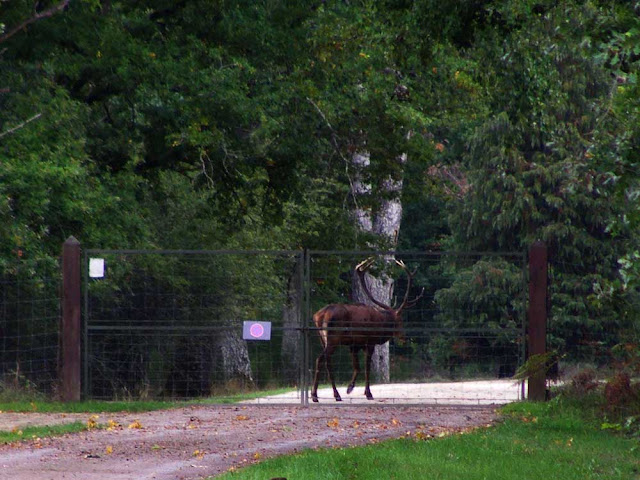We encountered this mystery building last Thursday on our walk in the woods south of Preuilly near la Berjaudiere. We're not quite sure what it is, but I am tempted to think that it's the remodelled corner tower of the Chateau's walled garden. Susan thinks the structure inside makes it look like it was once used as a pigeonniere (dovecote).
Thursday, 30 September 2021
Wednesday, 29 September 2021
The First Clunaic Daughter House
 |
| Lodgings and warehouses in the priory complex. |
Sitting on the banks of the Loire River, the small town of La Charité grew up around its imposing priory: the earliest daughter house of Cluny, a major site on the road to Santiago de Compostela, a masterpiece of Romanesque art and a World Heritage Site. The priory church of Notre-Dame remains today, despite its destruction and mutilation, one of the most important Romanesque churches in France and a high point of Romanesque art in the Nivernais part of Burgundy. An earlier monastery was built on this site around the year 700 and destroyed during the 'barbarian' invasions of the 8th century. Left abandoned, it was only in the middle of the 11th century that the monastery became prosperous. The by now important Cluniac priory was endowed during the 11th and 12th centuries with a church of rare splendor. It was the largest church in France after Cluny III: the marvelously decorated ensemble consisted of a façade with five portals under two towers, a nave of ten bays with double aisles, a wide transept with chapels and a large choir with an ambulatory and radiating chapels.
 |
| Cloisters. |
The complex was begun in the middle of the 11th century and was not completed until the middle of the following century. The town soon became an important stop on the route to Santiago de Compostela and, thanks to its reputation for providing hospitality to pilgrims, it earned the name La Charité. At its peak, the monastery ruled over 400 dependencies throughout the Christian world. The mother house at Cluny was reknowned for its strict adherence to the Benedictine rules, but its practice of operating as a federation of houses known as priories was different to other Benedictine monasteries, which retained their own independence as monasteries.
 |
| Apse. Note tiny house tucked in between apsidal chapels. Once upon a time this would not have been uncommon. |
The monastery church at La Charité was severely damaged by several fires, especially in 1559, when the town was devastated. Now, the large Romanesque church remains only in part. The huge nave no longer exists, but the remaining parts of the abbey church are enough to impress the visitor. First of all, there is a splendid bell tower, dating back to the 12th century, the only one left of the two bell towers of the Romanesque façade: the Sainte-Croix tower, magnificently decorated in its upper floors. Two Romanesque portals also remain from the façade, one still in place and the other reassembled in the church.
 |
| Inside the ruined nave, which is now an open courtyard, with houses and shops inserted into the outer wall. |
The tympanums are decorated with important story scenes of the Transfiguration and the Virgin, from the second quarter of the 12th century, stylistically resembling the royal portal of Chartres. At the foot of the bell tower is the Place Sainte-Croix, on the site of the first six bays of the Romanesque nave, where you can see features from the end of the 11th century. The current nave, smaller, was rebuilt in the 17th century. Fortunately, the transept and the choir of the Romanesque abbey church are intact. It is a magnificent ensemble, built on three floors, an example of Cluniac Romanesque art in all its splendor. Initially, in the 11th century, there was a two-storey transept and a choir with a central apse surrounded by six apsidioles staggered according to the plan of Cluny II. In the 12th century, a major reconstruction campaign was carried out under the influence of Cluny III: the three central apses were replaced by a large three-storey choir with an ambulatory and five radiating chapels, the 11th century transept was raised by one floor and pointed barrel vaulted, like the choir.
 |
| Transept crossing. |
The transept crossing, vaulted with a beautiful dome, is topped by a bell tower of one octagonal floor, the Bertrange Tower. The church is magnificently decorated with five-lobed arches with decorated pilasters, a feature very particular to this building, which can be found on the bell towers, the choir and on the outside on the upper floor. The sculpture of the abbey church is the glory of La Charité: no other Romanesque church is so richly decorated from top to bottom, inside and out. There are sculpted bas-reliefs of animals and figures, modillions with heads and animals at the apse, richly decorated pilasters, and several hundred capitals throughout the transept and choir.
 |
| The original front of the church. |
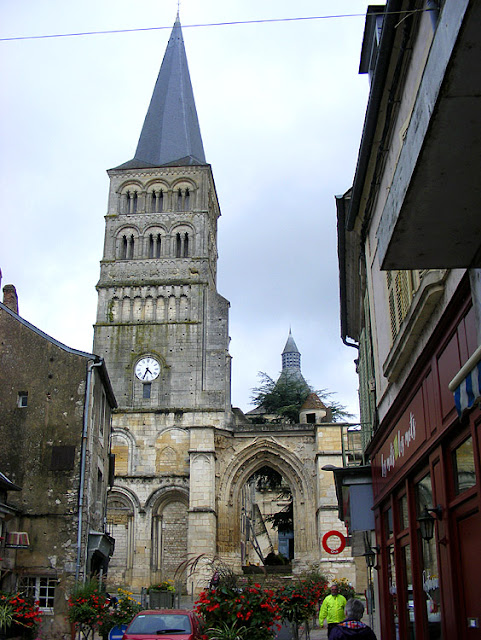 |
| The first sight of the priory complex after crossing the bridge over the Loire. |
 |
| The Virgin Tympanum. |
 |
| Lodgings at the back of the nave. |
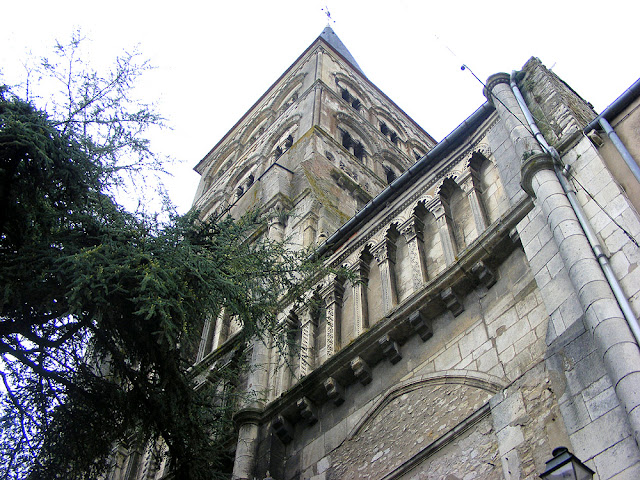 |
| Belltower. |
 |
| Transfiguration Tympanum. |
Tuesday, 28 September 2021
Christo, Eat Yer Heart Out
For those of you unimpressed by Christo's work, here is a French project you may get on with better.
If you travel around the rural back blocks of France like we tend to, you will occasionally notice candy pink plastic covered hay bales sitting in fields. And you might wonder what it is all about.
It turns out it is all about supporting breast cancer awareness and research.
Roughly 50% of people working in agriculture are women, so it is perhaps not so surprising that the sector may wish to support breast cancer research.
Monday, 27 September 2021
Auberge de la Poule Noire, La Charité sur Loire, Nievre
We didn't eat at the Auberge de la Poule Noire (the Black Hen Inn) but it is an attractive building in La Charité sur Loire, Nièvre, photographed on our recent travels.
Sunday, 26 September 2021
Growing up in Sydney
I have written before about when my family moved from London to Australia. (Emigrating to Australia Part One, Part Two, Part Three). I have also written about breaking my arm in the park opposite our house. The story of that is here. The park still exists, but it has much more modern features such as safety and shade. You can see it here.
Yesterday I was looking for some old photos and I found the following, one of the the first photos taken of me in Australia. The date on the photo is October 1967, but I have no idea when it was taken: back then you took the occasional photo, then when the film was full you took it to the chemist to be developed. All I know is that it was taken between April and October 1967.
You can see the "slippery dip" (a.k.a slide) that I broke my arm on in the left background.
Later Dad taught me how to develop film, and we did so in the bathroom, using
a red plastic bucket over a lightbulb to provide us with suitable light. I
assume it was cheaper, and I remember the results were quite acceptable.
Saturday, 25 September 2021
La Maison du Sabotier, La Charite sur Loire, Nievre
This early 16 century house is a listed building in La Charité sur Loire, 200 kilometres to our east. We've just had a few days away staying nearby at the chateau owned by some new Aussie friends.
Before becoming a private home this building was probably a shop. The name translates as 'the clog maker's house'.
Friday, 24 September 2021
A Third of Species Threatened in Touraine
A third of species are under threat in the Touraine -- particularly insects, birds and amphibians. It's linked to the usual suspects -- change of land use, destruction of habitats and agricultural chemicals. More and more municipalities are getting biodiversity surveys done and taking action to restore important habitat such as wetlands, heaths and unimproved pasture.
Recently the International Union for the Conservation of Nature (IUCN) met in Marseille. They are the organisation that oversees the Red List of Endangered Species. Nowadays, it's not just Bengal Tigers and Komodo Dragons on the list, but all sorts of animals that are closer to home. Here in the Touraine it is the Société d'études pour la protection et l'aménagement de la nature en Touraine (known by its initials, Sepant) which is sounding the alarm.
 |
| Agile Frog. |
The data from the regular biodiversity surveys conducted by Sepant are sent to the National Biodiversity Observatory, and to the IUCN. Four groups in particular are being closely monitored -- birds, insects, amphibians and molluscs. Sepant estimates that 30% of insect species are threatened, and the other groups are compromised too.
The losses are directly linked to urbanisation, destruction of natural habitats, and chemicals used to treat crops. In Indre et Loire calcareous grasslands, heaths and damp grasslands are particularly vulnerable. Already, the disappearance of hedgerows has sounded the death knell for the Meadow Lark (Fr. Tarier des prés). The Scarce Large Blue butterfly Maculinea teleius (Fr. l'Azuré de la sangsuisorbe) is critically endangered. And the Agile Frog Rana dalmatina (Fr. grenouille agile) hasn't been seen in Tours since 1975.
 |
| Large Blue butterfly Maculinea arion (Fr. Azuré du serpolet), also declining in numbers. |
The elected city council of Tours is allied to the Ecology Party politically, so they have commissioned a biodiversity survey of the city, and are engaged in the conservation restoration of several important habitats, such as a marsh at Notre-Dame-d'Oé and a traditionally/conservation grazed heath at Larçay.
Thursday, 23 September 2021
Millions of Spores and a Lacquered Cap
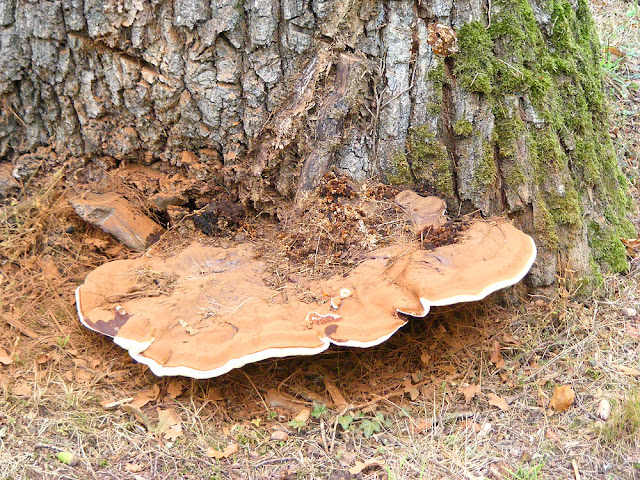 |
| Covered in spores (like a brown powder). |
A splendid Artist's Fungus Ganoderma applanatum (syn G. lipsiense, Fr. Ganoderme plat), pumping out brown spores for all it's worth, at Ribaloche (forest of Preuilly), photographed last week. It's on a still living, but doomed, oak tree.
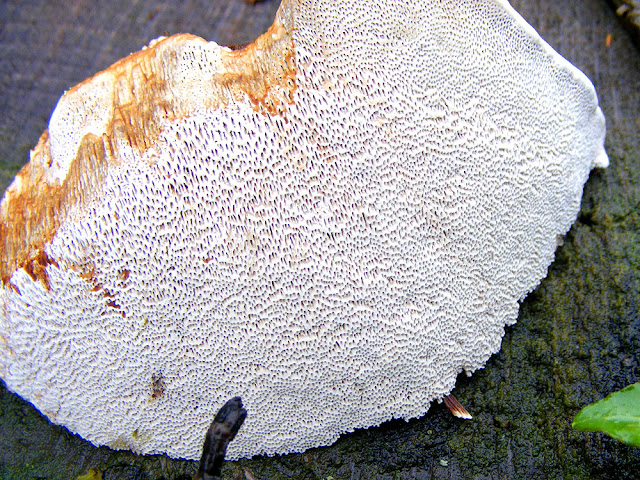 |
| The underside showing the pores. |
 |
| A few days later the rain had washed the spores off, revealing the lacquer like top. |
 |
| A cross section, revealing along the cut on the right light brown flesh and darker brown tubes ending in the cream pores. |
Wednesday, 22 September 2021
Wrapping It Up
Paris is currently admiring the final work planned by the artists Christo and Jeanne-Claude, both of whom are now dead. The Arc de Triomphe has been wrapped in a specially woven fabric and the work will be on display for a fortnight.
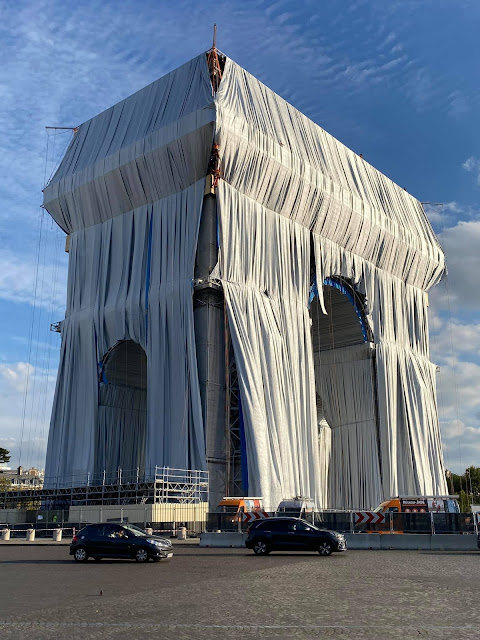 |
| The Arc de Triomphe in the process of being wrapped. (Photo courtesy of Wendy van der Beek). |
The pair are much admired in France and the work has received a good deal of fanfare. American tourists, on the other hand, are mostly unimpressed. They want the monument they have in their guide books back, and have barely heard of Christo.
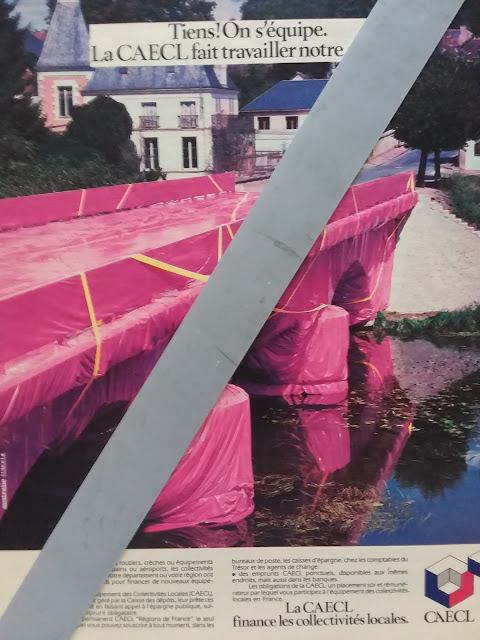 |
| The bridge in Preuilly wrapped in 1985. |
One of Christo and Jeanne-Claude's previous projects in Paris involved wrapping the Pont Neuf, in 1985. Much to my amusement, I discovered recently that Preuilly sur Claise got in on the act and created a copycat version. Our own Pont Neuf was wrapped in pink as a sort of publicity stunt.
Australians may remember that one of the couple's early works was Wrapped Coast, where they wrapped the coast at Little Bay in Sydney Harbour in 1969.
Tuesday, 21 September 2021
Carpenters Without Borders at Amboise
The volunteer heritage conservation organisation Charpentiers sans frontiers (Carpenters without borders) has been working on the restoration of the Chapelle Saint Hubert in the grounds of the Chateau Royal d'Amboise. They make up the first phase of a 2.7 million euro, 2 year project to repair the roof. Last Tuesday I was lucky enough to have a long conversation with one of the women carpenters. She has been a professional carpenter for 20 years, working mainly on modern timber framed homes in the UK, but she is passionately interested in building conservation, and this week in Amboise was her annual holiday.
 |
| Charpentiers sans frontiers have set up on the terrace near the chapel. |
The Charpentiers sans frontiers team is 30 people from 7 countries, including France, the US, England and Germany. They are working with traditional tools to hew (that's the correct technical term for working the logs with axes) and saw (with a two man cross cut saw over a pit) 20 oak trees between 60 and 80 years old, donated from the nearby Forest of Amboise so they become beams, base plates and rafters.
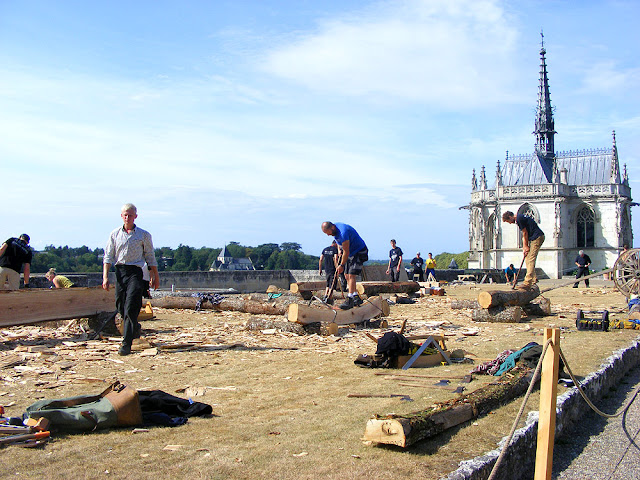 |
| The two curved logs on the right will become the base plates for the apse roof. |
The 19th century spire was added without being adequately fixed to the roof, and this is the main problem being rectified by the carpenters as they rebuild the apse roof. The beautiful spire will be completely rebuilt too, entirely by hand.
All of this work is being undertaken so visitors can view it, and the carpenters are very happy to break off and answer questions. The smell of freshly cut oak pervades the Chateau grounds and is rather nice.
 |
| Carpenters consulting. |
After the carpenters will come lead roofers and decorative finial makers, masons, sculptors and stained glass artisans.
The chapel is most famous for housing the tomb of Leonardo da Vinci. It was last restored a 140 years ago. The Chateau Royal d'Amboise is owned by the Fondation Saint Louis. The restoration is being 84% funded by the State, as part of the Covid19 Relaunch programme for the tourist industry. 2.5 million euros will go towards the restoration itself, 200 000 euros is earmarked for outreach and heritage conservation education.
 |
| This carpenter from England stopped work to talk to me. |
It is only the third phase of major work ever undertaken on the Chapel. It was built in a single phase at the very beginning of the 16th century, and from then on fell progressively into decline and abandonment. The Royal Apartments which abutted it were demolished in the 19th century. There were two major phases of restoration in the 19th century -- the first under Louis Philippe (the last King of France, 1830 - 1848), the second, at the end of the 19th century, at the instigation of the Count of Paris (a pretender to the French throne).
For the length of the project there will be booths set up in the grounds dedicated to educating the public about all the trades who will be involved. By the time the work is finished, the lead roof will have been given back its gilt highlights, and the bell will once again ring out, after being silent for as long as anyone can remember.
Monday, 20 September 2021
Apples and Pears Are In
This year's pear harvest is in, with Doyenne de Comice, Beurre Hardy, Conference, President Heron and others now at the market from our local organic orchardists Sandy and Tony (and their newborn Diego). Their early apples are also in -- Royal Gala and a new variety with a name that sounded like Ican.
 |
| Tony the organic orchardist at the market in Preuilly. |
On Sunday I picked some from each of Reine de reinette, Red Delicious, Golden Delicious, Granny Smith, Melrose and Jonagored but there are still plenty on the trees in our orchard. This year our pears didn't flower, so no fruit.
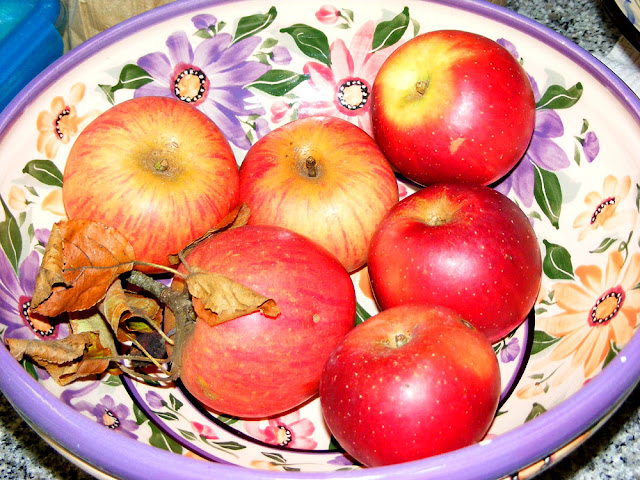 |
| Homegrown apples from our orchard. |
Apples and pears grow extremely well in the Loire Valley. To read more about them, go to my posts on Apples in the Loire Valley [link] and Pears in the Loire Valley [link].
Sunday, 19 September 2021
Saturday, 18 September 2021
(not) Chairlifts of the World
Unlike the last two Saturdays, this isn't a chairlift: it's the cable up Sugarloaf in Rio.
And another pic: behind the hairy stranger you can see Copacabana.
Friday, 17 September 2021
The Coachman's Plaque
Earlier this year my friend Joël pointed out a historical curiosity in Le Grand Pressigny. Fixed to a corner of a house there is a metal plaque.
It is a coachman's plaque, still in place at the corner of the street where the Relais de Poste was a stopover on the Le Grand-Pressigny route. Placed at the right height to be read by the coachman and the drivers of horse drawn vehicles in general, who were perched up high, it still shows us the route the stage coach took.
The route was designated as the Chemin de Grande Circulation No 13 in the 19th century, running between Chatillon sur Indre and La Guerche. Today that route is the D(épartementale)13.
Thursday, 16 September 2021
What Happened to All Those Messages? (Repost from 13 November 2017)
As you may have seen in the news, the trial of the Paris terrorists is underway. This has brought back a lot of memories for many people. I thought I would repost a blog I did as a response to the two year anniversary of the Bataclan attack. We were in Paris about a week after the Charlie Hebdo attacks, staying just around the corner from where they took place. Later, we were in Paris about a week before the Bataclan attacks, again staying just around the corner.
********************************************
In late October [2017] I was whiling away the time at the ophthalmologists, reading a copy of Grazia from November 2016. Inside, the article that really caught my attention was a two page spread about saving all the thousands of messages and tributes that had been left by people at the sites of the terrorist attacks in Paris twelve months earlier. I was fascinated and moved so I thought I'd pass on the story via the blog.
Today in the Archives de Paris there are two shelves which are home to the 7689 documents that they collected from the streets after the attacks on 13 November 2015. This collection was the brainchild of a man called Gérôme Truc. He felt it would allow historians and sociologists to have access to another dimension of the event ie how ordinary individuals experience these things and respond to them.
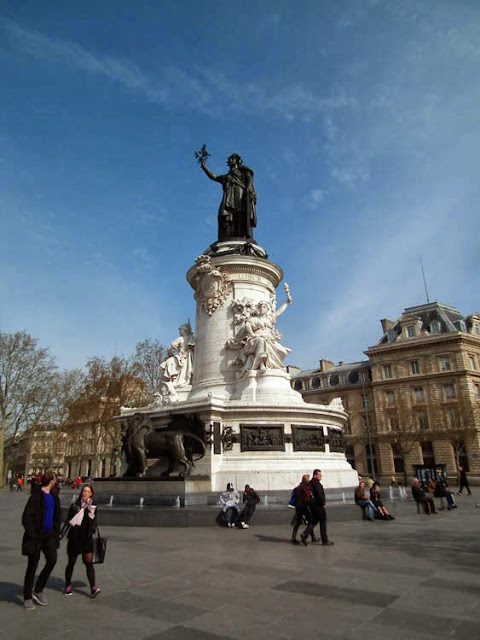 |
| Place de la République, Paris. |
The documents come from the Bataclan, la Belle Equipe, the Café Bonne Bière, Casa Nostra, the Carillon, the Petit Cambodge and the Comptoir Voltaire. Ten volunteers collected the messages of love from Parisians, French people and foreigners, bit by bit from 17 November.
In addition two archivists and a conservator made 17 visits to the sites. According to them the most affecting was visiting the Bonne Bière because there was a message found there from an intensive care doctor, who apologised for being unable to save a young man.
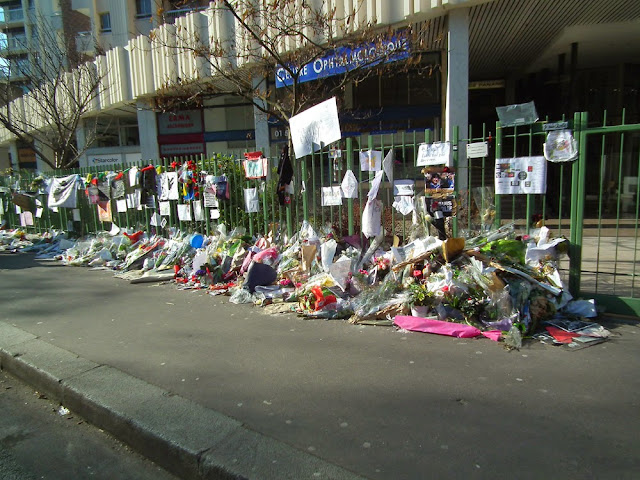 |
| Tributes placed in Boulevard Richard Lenoir after the Charlie Hebdo attacks. |
The archive staff assessed the condition of the messages, children's drawings and poems. The main problem was plastic pockets. They were useless because the rain quickly got into them and turned the contents to mush.
Back at the Archives, the documents were dried in two sorting rooms. Usually overnight was enough to dry them out. They were then sent to be fumigated to kill mould and other fungi before being left for three weeks to stabilise. Once returned to the Archives, the documents, from metro tickets to A3 in size, were dusted with a microfibre cloth then sorted by place and date before being digitised (thanks to a donation by Arkhênum).
 |
| Tributes placed in Boulevard Richard Lenoir after the Charlie Hebdo attacks. |
The archivists didn't look at the documents. They had no time and they needed to maintain a certain distance emotionally. While they worked the tried to be calm and converse normally, even crack jokes.
The Museum of Paris, Carnavalet, conserved all the objects (soft toys, guitars, flags...) but those that didn't carry a meaningful message were thrown away. There was a debate about what to do with the wilted flowers. Gerôme Truc suggested that like in London in 2005, the flowers should be collected, composted and a tree planted in the compost.
 |
| Bataclan Theatre. |
A hundred and fifty documents were recovered from the temporary memorial in the Place de la République. The rest of the messages from this spot were kept by the collective known as 17 Plus Jamais, created the day after the Charlie Hebdo attack in January 2015.
At the time of the Charlie Hebdo attacks the archival work was not able to be applied to the messages to the murdered cartoonists and they were deposited at various sites. At the time the Mairie de Paris just didn't think of preserving and cataloguing them. Eventually Harvard University launched an appeal to collect the messages after the event, and many of them are now in the US.
 |
| Tributes laid at the Charlie Hebdo offices in Paris, after the attack. |
900 of the messages were published by Michel Lafon in Je suis Paris.
Wednesday, 15 September 2021
Last of the Wild Orchids for the Season
As predicted, now we've had a bit of rain, the Autumn Lady's Tresses Spiranthes spiralis (Fr. Spiranthe d'automne) have shot up and are flowering. Keep an eye out for them, as they are not easy to spot. They are a rare and protected species, which we are lucky to have in reasonable numbers here, albeit in localised colonies with numbers ranging from a single plant to maybe 60 individual plants in a few places. They like to be dry in summer and wet in winter.
Tuesday, 14 September 2021
The Rut Has Set In
I had a fun experience on Saturday night. We had dinner at a friend's place, along with lots of others, for her unbirthday. She lives in the middle of the Loire Valley countryside, in an old farmhouse on a ridge surrounded by open fields. Beyond the fields is forest all around. The Red Deer rut (le brame in French, mating season) has started, so she and I stood out in the dark at about 10pm and listened to the stags roaring. They come out of the forest into the open to strut their stuff. It was only a crescent moon so we couldn't see them, but the sounds of several stags competing is impressive enough. For Australians, like me, they sound remarkably like male Koalas engaged in the same activity! (The photo is of a stag I took several years ago on the Chateau of Chambord estate.)
Monday, 13 September 2021
Vegetarian Meals in School Cantines
From the beginning of the new academic year, schools in Poitiers are serving two vegetarian meals a week in their cantines. For example, the menu for Tuesday last week was radishes with butter (a very traditional French favourite) as a starter, diced mixed vegetables and a vegetarian crumbed pattie made from wheat, emmental cheese and spinach for main course, followed by a portion of organic camembert cheese and some plums.
 |
| Radishes at Loches market. Super popular. All these will get sold within hours. |
The schools have been serving a vegetarian menu once a week since 2009. The kids seem to have taken to it well, after some initial hesitation. In 2018 a new national law required all schools to serve a vegetarian meal. From now on, in Poitiers at least, it will be two meals a week. One will be egg based, the other featuring mainly organic vegetables.
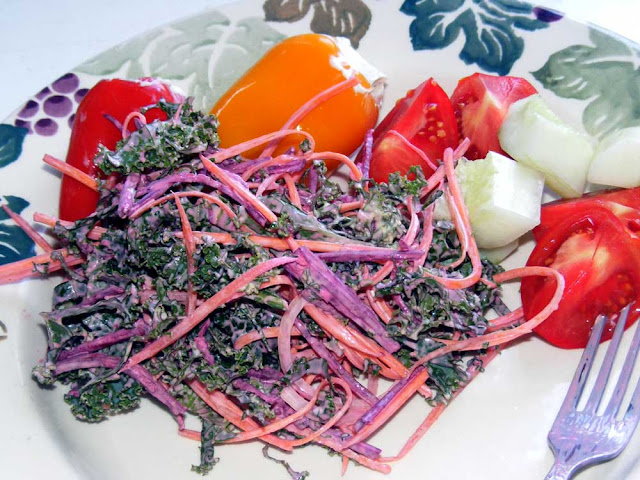 |
| Random homemade vegetarian meal made with local organic produce, chosen by Simon to illustrate the post. Kale slaw, cream cheese stuffed mini peppers, cucumber and tomatoes. |
The City of Poitiers prepares and serves 1.2 million meals a year, of which 800 000 are school meals. They are aiming to reduce their environmental impact by transitioning to vegetarian meals. They are also aiming to increase by 10% every year their purchasing from local, organic and certified (eg Label Rouge) producers and suppliers.
 |
| Camembert box. |
The school cantine directors note that there is no more wastage with vegetarian meals than any other. They have had to work on developing recipes and ensuring they are delivering a good range of dishes, but they say it is no more complicated, just less culturally embedded. Kitchen staff have had to be trained, and the reactions of the kids has been carefully monitored.
 |
| Another random homemade vegetarian meal made with local organic produce, chosen by Simon to illustrate this post. Sautéed sweet peppers, onions, carrots and potatoes. |
Today, 85% of kids will take the vegetarian meal at school. More training is planned for the staff so that they can continue providing creative vegetarian food. The City also plans to send Aged Care Home kitchen staff for training too.
Sunday, 12 September 2021
Australia on a Sunday
We are accustomed to posting something about Australia on Sundays. This Sunday we have not got a lot to say - last time we were in Australia was 4 years ago, and the way the government is bungling the response to the pestilance it feels like it will be another 4 years until we visit again.
Of course - if I was an Australian politician or professional sportsman I could travel wherever and whenever I like on any pretence at all. But that's not for the likes of us, even if we did have have a compelling need.
So instead, a photo I took almost 20 years ago on the Western Plain of New South Wales.
Saturday, 11 September 2021
Chairlifts of the World
I mentioned last week that I have been on chairlifts in many places. One of those places was China, where Susan and I rode on a chairlift up to the top of the Great Wall. The ones in France feel safer...














